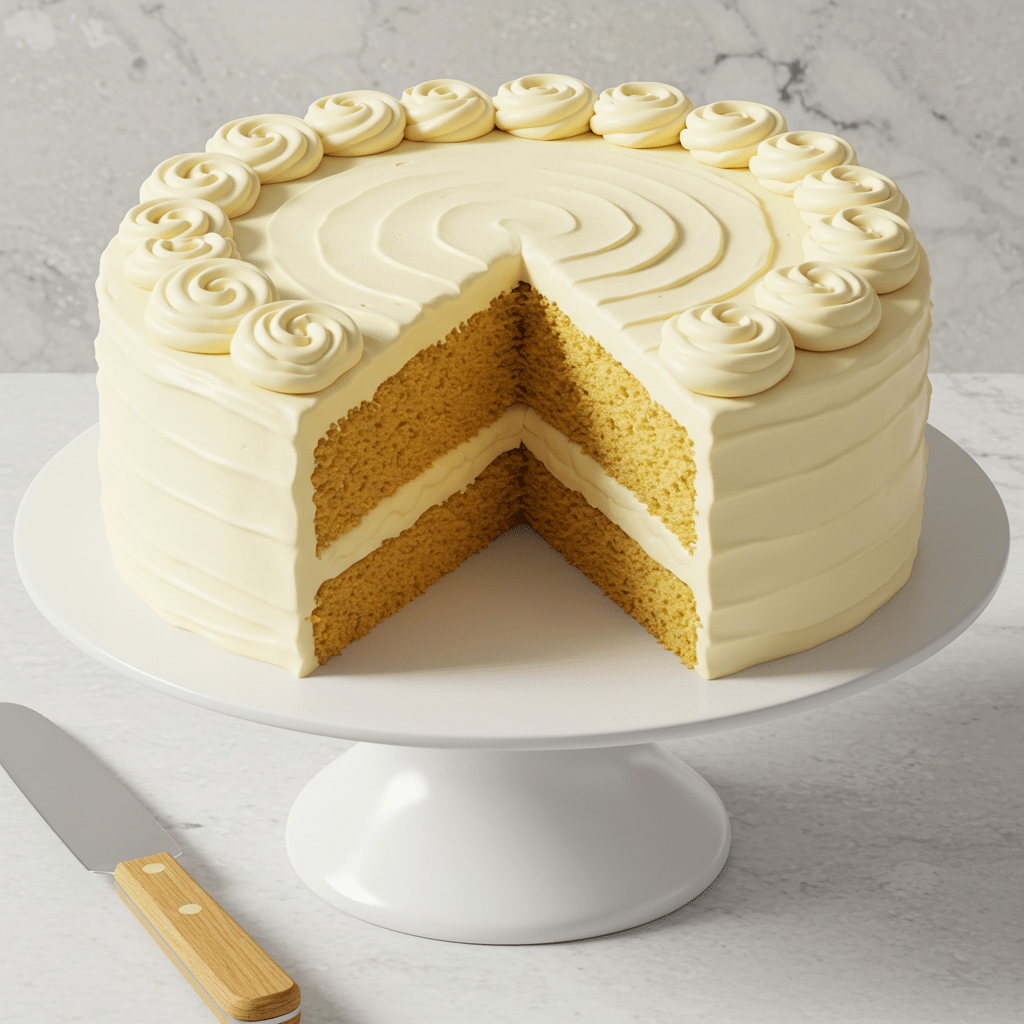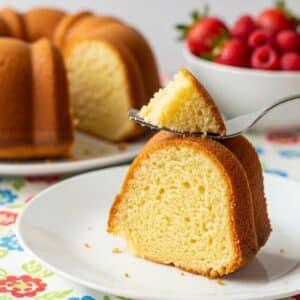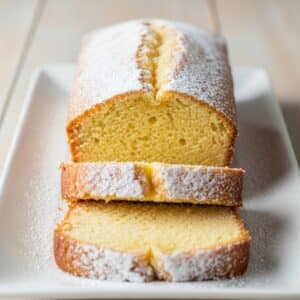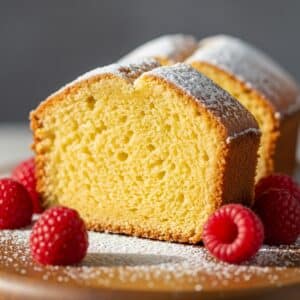Nothing beats the simple joy of baking a soft, buttery vanilla cake from scratch. This easy vanilla cake recipe brings together rich flavor, tender texture, and an aroma that fills your kitchen with warmth. Each bite feels perfectly moist, thanks to the combination of whole milk and sour cream, while the buttercream frosting adds light sweetness. Whether for birthdays, Sunday gatherings, or everyday desserts, this cake is a classic choice that never goes out of style.
Getting the Basics Right
Perfecting Ingredient Temperature
Room-temperature ingredients are key for even mixing. Butter, eggs, milk, and sour cream should all be at similar temperatures to ensure the batter blends smoothly. Cold ingredients can cause curdling or uneven texture, while properly softened butter traps air during creaming, giving the cake a soft rise. Always let ingredients sit out for about 30 minutes before starting.
🧾 Want to keep this recipe for later? Download your printable PDF version now and enjoy it anytime!
📥 Download Recipe PDF✅ Print-friendly • 🕒 Save for later • 📱 Mobile-accessible
💡 Want more like this? Subscribe to our weekly printable recipes!
Measuring with Accuracy
Precision makes or breaks a cake. Scoop flour gently into your measuring cup and level it off without packing. Too much flour leads to a dense texture, while too little makes the cake fragile. Use a kitchen scale for best results. When it comes to liquids, measure in a clear jug at eye level for perfect consistency every time.
Print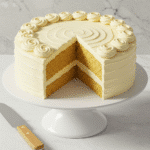
Easy Vanilla Cake Recipe
- Total Time: 60
- Yield: 12 servings 1x
- Diet: Vegetarian
Description
A classic vanilla cake with a soft crumb and buttery vanilla flavor, topped with fluffy buttercream frosting.
Ingredients
FOR THE VANILLA CAKE
2 ½ cups (312g) all-purpose flour
2 ½ tsp baking powder
½ tsp baking soda
½ tsp salt
¾ cup (170g) unsalted butter, room temperature
1 ¾ cups (350g) granulated sugar
4 large eggs, room temperature
1 tbsp pure vanilla extract
1 cup (240ml) whole milk, room temperature
½ cup (120ml) sour cream, room temperature
FOR THE VANILLA BUTTERCREAM
1 cup (227g) unsalted butter, room temperature
4 cups (480g) powdered sugar, sifted
2 tbsp heavy cream or milk
1 ½ tsp pure vanilla extract
Pinch of salt
Instructions
1. Preheat oven to 350°F (175°C). Grease and line two 8-inch round pans.
2. Whisk flour, baking powder, baking soda, and salt.
3. Beat butter and sugar until fluffy, 3–4 minutes.
4. Add eggs one at a time, then mix in vanilla.
5. Combine milk and sour cream.
6. Add dry ingredients alternately with wet, mixing gently.
7. Divide batter evenly into pans and bake 30–35 minutes.
8. Cool 10 minutes, then transfer to wire rack.
9. For frosting, beat butter until smooth.
10. Add powdered sugar gradually, mixing on low.
11. Add vanilla, salt, and cream. Beat until fluffy.
12. Frost cooled cakes, layer, and decorate.
Notes
Ensure ingredients are at room temperature for even mixing. Avoid overbaking for the softest crumb.
- Prep Time: 25
- Cook Time: 35
- Category: Dessert
- Method: Baking
- Cuisine: Canadian
Nutrition
- Serving Size: 1 slice
- Calories: 340
- Sugar: 30g
- Sodium: 210mg
- Fat: 14g
- Saturated Fat: 8g
- Unsaturated Fat: 5g
- Trans Fat: 0g
- Carbohydrates: 47g
- Fiber: 1g
- Protein: 5g
- Cholesterol: 60mg
Mixing the Batter
Creaming Butter and Sugar
Begin by beating unsalted butter and granulated sugar together until pale and fluffy. This step incorporates air, giving your cake its tender crumb. Mix for 3 to 4 minutes, then scrape down the sides of the bowl. The mixture should look creamy and smooth, with a slightly glossy appearance. The sweet aroma of butter and sugar signals that it’s ready for the next step.
Adding Eggs and Vanilla
Crack in the eggs one at a time, mixing after each addition. This allows the structure to develop without deflating the air. Once the eggs are fully blended, mix in pure vanilla extract to bring that iconic bakery-style flavor. Vanilla’s richness enhances the natural sweetness of the cake and adds a comforting depth perfect for any celebration.
Combining Dry and Wet Ingredients
Mixing the Dry Ingredients
In a separate bowl, whisk together flour, baking powder, baking soda, and salt. Whisking helps distribute the leavening agents evenly so the cake rises uniformly. A well-blended dry mix ensures no pockets of baking powder or soda remain, preventing any bitter aftertaste. Keep it light to maintain the cake’s fluffy consistency.
Alternating Wet and Dry Mixtures
Slowly add the dry ingredients to the creamed mixture, alternating with the milk and sour cream combination. Begin and end with the dry mixture. This technique keeps the batter smooth without overmixing. Once fully incorporated, the batter should have a silky, thick texture that pours easily but holds shape. This stage defines the cake’s moisture and crumb.
Baking to Perfection
Preparing Pans and Oven
Preheat the oven to 350°F (175°C). Grease and flour two 8-inch round cake pans, then line the bottoms with parchment paper. This simple preparation ensures the layers release easily after baking. Place the pans on the middle rack for even heat circulation, avoiding overbrowning on the edges.
Testing for Doneness
Bake for 30 to 35 minutes or until a toothpick inserted in the center comes out clean. Avoid opening the oven door too early, as sudden temperature drops can cause sinking. Once baked, the cakes should spring back lightly when touched. Their golden tops and subtle vanilla scent make them irresistible right out of the oven.
Cooling and Frosting
Cooling the Layers
Let the cakes rest in the pans for about 10 minutes before transferring them to a wire rack. This cooling period prevents them from breaking. Once completely cool, the cakes will have the perfect structure for frosting and layering. Patience here ensures smooth results when spreading the buttercream.
Making the Buttercream
In a large bowl, beat room-temperature butter until creamy. Gradually add sifted powdered sugar, mixing on low until combined. Add vanilla extract, a pinch of salt, and a few tablespoons of cream or milk. Increase the speed and whip for 3 to 4 minutes until the frosting becomes fluffy and spreadable. If it’s too thick, add a tablespoon of milk at a time until it reaches the desired consistency.
Assembling the Cake
Layering the Cake
If needed, trim the tops of the cooled cakes to level them. Spread a generous layer of buttercream on the first cake, then place the second layer on top. Press lightly to secure. Apply a thin crumb coat to seal in any loose crumbs, then chill for 15 minutes. This step helps achieve a smooth and professional finish.
Frosting and Decorating
Once chilled, spread the final layer of buttercream evenly using an offset spatula. Smooth the sides and top for a clean look. For a touch of creativity, decorate with sprinkles, edible flowers, or fruit slices. You can also draw inspiration from the easy moist homemade vanilla cake for more decorating tips that make your cake presentation shine.
Serving and Storing
The Best Way to Serve
Slice the cake with a warm, clean knife for neat edges. This cake pairs beautifully with coffee, tea, or fresh berries. The soft texture and buttery flavor make it suitable for both casual gatherings and formal events. Each bite melts in your mouth with a balance of sweetness and creaminess.
Storing for Freshness
Store leftover cake in an airtight container at room temperature for up to two days or refrigerate for a week. To freeze, wrap unfrosted layers in plastic wrap and store for up to three months. When ready to serve, thaw at room temperature and frost fresh. Proper storage keeps the cake moist and flavorful for days.
Troubleshooting Common Issues
Why Is My Cake Dense?
A dense cake often results from overmixing or using too much flour. Mix gently and only until the batter comes together. Check that baking powder and soda are fresh to maintain lift. Accurate measurement and careful mixing ensure a soft, airy crumb every time.
How to Fix Dry Cake Layers
If your cake turns out dry, brush each layer with simple syrup before frosting. This quick fix restores moisture and enhances flavor without changing texture. Keeping an eye on bake time also helps; every oven differs slightly, so check for doneness a few minutes early.
Variations and Add-Ons
Adding Flavor Twists
This recipe serves as a great base for many variations. Add lemon zest for a citrus kick, fold in shredded coconut for texture, or mix in a layer of fruit jam between cakes for extra sweetness. Small adjustments make this cake uniquely yours while keeping its classic charm.
Turning It into Cupcakes
The same batter works beautifully for cupcakes. Pour into lined muffin tins and bake for 18 to 20 minutes. Top with buttercream swirls and sprinkles for an easy party treat. The cupcakes stay moist and light, ideal for birthdays or bake sales where you want that perfect homemade touch.
FAQ
Can I use oil instead of butter?
Yes, but it will change the flavor slightly and make the texture softer and less buttery.
Can I make this cake ahead of time?
Absolutely. You can bake the layers a day early and frost them on the serving day.
Can I double this recipe for a larger cake?
Yes, simply double the ingredients and use larger pans or bake in batches.
What’s the best way to color the frosting?
Use gel-based food coloring for vibrant shades without thinning the buttercream.
Can I use cake flour instead of all-purpose flour?
Yes, but reduce the total by about 2 tablespoons to maintain structure.
Conclusion
This easy vanilla cake recipe combines simplicity with elegance. With its soft crumb, buttery flavor, and silky frosting, it stands out as a must-bake for every home baker. Whether you’re celebrating a milestone or craving a sweet slice on a quiet afternoon, this cake delivers satisfaction every time. From accurate measurements to gentle mixing and perfect frosting, it’s a reliable recipe you’ll return to again and again.

